The New, Improved Prime Plug-in
For years, Toyota has danced around electricty, perhaps fearful it would get schocked. But this year the company is back in the electric game (barely) with the 2017 Toyota Prius Prime, a plug-in hybrid electric vehicle (PHEV) based on the 2016 Prius Liftback. Plug-in hybrids are a strange lot that are beginning to be noticed. They attract buyers who want a longer distance of all-electric driving (and in some places perks like solo HOV lane access), but aren’t ready to jump to a full electric vehicle.
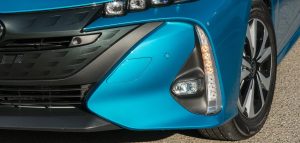
Since its 1997 debut in Japan, Toyota’s Prius has become the gold standard of gasoline-electric hybrid cars. The origional four-door Prius subcompact sedan grew to become the compact-size Prius Liftback, then the automaker added the larger Prius V along with smaller Prius C and, for a short while, the Prius Plug-in.
With a fully charged battery the Prime can travel 25 miles of electric-only driving before seamlessly switching to the hybrid drivetrain. Combined, the Prime can travel 640 miles without charging the battery or filling the gas tank. In contrast, the Chevrolet Volt has double the electric-only driving range of 53 miles (but 420 miles of combined range). But that is not the only criteria for judging the two approaches to the same technology.
The Prius Prime has an EPA estimated miles-per-gallon-eqivalent (MPGe) of 133, the Volt comes in at 106 MPGe. MPGe is the government’s rating to try to help consumers understand how much energy an electric or hybrid car is using in combined city/highway driving. Also, the Prime achieves 54 mpg in combined driving when operating as a normal hybrid, whereas the Volt returns only 42 mpg combined.
The 2017 Toyota Prius Prime comes in three flavors: Plus, Premium, and Advanced. The Plus carries an MSRP of $27,100; the Premium comes in at $28,800; and the top-tier Prime Advanced is $33,100. Prices are before an available federal tax credit of $4,500 and any potential state incentives.
New Hybrid Powertrain
The 2017 Toyota Prius Prime is the first Prius to use a dual-motor drivetrain. It adds a one-way clutch to motor-generator 1 (MG1) so that both electric motors now help drive the wheels. Previously, the MG1 just started the gasoline engine and took care of regenerative braking. Now, when operating as an EV, there are two electric motors powering the wheels, which increases electric driving range and improves performance.
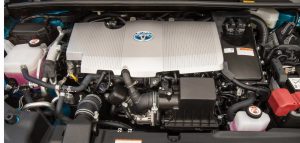
Lift the hood and you’ll find that the Prime packs the same engine as the Prius liftback: a very efficient 1.8-liter Atkinson-cycle inline-four making 95 horsepower. Combined with the electric motors, the hybrid system’s net output is 121 horsepower at 5,200 rpm and 105 pounds-feet of torque at 3,600 rpm. That’s good for a 0 to 60 mph run of a little less than 11 seconds — just quick enough to merge onto a fast moving freeways with just a little sweat.
There are three different drive modes: HV mode combines the gasoline engine with electric power from the battery to drive the vehicle; EV mode uses the battery alone; and EV Auto Mode switches between the two for the most efficient drive, relying mostly on electric power but calling up the gas engine as needed.
HV mode slowly recharges the battery, but if you hold down the HV button for a few seconds, the car will use more of the gas engine’s power to charge the battery faster, up to 80 percent of its full capacity.
Within the three drive modes are three sub modes: Eco, Normal, and Power. The main difference between the three is acceleration. In Eco mode, there is a hesitation when you press the accelerator pedal, though it evens out as your speed increases. Normal mode feels… normal, while Power is the sharpest the three.
The 8.8 kilowatt-hour (kWh) lithium-ion battery pack located in the trunk area is double the size of the previous Prius plug-in model, and the pack now has a warming system. When plugged in, the battery will warm up so the vehicle can start in full EV mode even if it is freezing outside. A charge takes about two hours at 240 volts or less than five hours at 120 volts.
As with other plug-ins, the Prius Prime allows you to reserve your EV charge for later—for example, drive in hybrid mode for a highway speed journey and then switch to EV mode for in-city travel.
Prius Prime Has Different Styling
Although the Prime is essentially a regular Prius Liftback that plugs in, it boasts styling that is different and easily noticed. Up front, the 2017 Toyota Prius Prime borrows from the Toyota Mirai fuel cell car with bigger air intakes. It has a front grille that is blacked out in the center with LED foglight strips that are much longer than the ones found on the standard Prius.
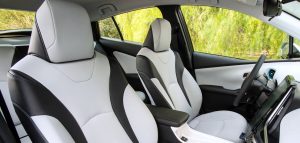
Out back, the Prime’s taillights stretch across the top of the rear end and encircle the lower glass to form two C-shaped patterns. Additionally, the Prius Prime also has LED light clusters in the lower rear fascia that look like rear-mounted fog lights. Accommodating the larger lithium-ion battery meant turning the Prius Prime into a four-seater. To recoup some of the lost cargo space, the Prime is four inches longer than the base Prius. These design changes give the Prius Prime a bolder, sportier look compared to the regular Prius.
Inside the cabin is where you’ll find another key difference between the standard Prius and Prius Prime. Having only four seats was a major objection when Chevy’s Volt was introduced, but there’s been little said about the Prime missing a rear seat position.
The traditional top-of-dash mounted gauges are there so Prius fans won’t get confused by traditional gauge placement behind the steering wheel. But the kingpin of the cabin’s design and tech features is the large infotainment screen. The base model comes with a seven-inch touch screen, while all other Prius Prime trims feature an 11.6-inch screen in the center of the dash. An in-dash color display is a short cut you use to view much of the data that’s on either of the bigger displays, making it simpler and easier to read at a glance.
Four bucket-style seats are standard on the base Plus model as are: cloth upholstery, heated front seats, automatic temperature control, Toyota’s Entune audio system with integrated navigation shown on a seven-inch display screen, and a back-up camera. I found both front and rear seats were comfortable with plenty of leg, head and shoulder room for my five-foot, 11-inch frame.
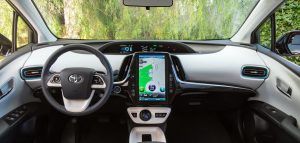
As futuristic as the Prius Prime’s exterior styling is, apparently Toyota thinks it looks high-tech to have high-gloss plastic trim like an old Apple iPod along with white upholstery. My take is the white version will easily get dirty and stained, and not only that, the materials are not very rich-looking.
Note to families with young children: don’t buy a Prius Prime with a white interior.
Compared to the regular Prius, the Prime comes up short when it comes to cargo space. The rechargeable battery pack’s location not only removes several cubic feet of space, but also the spare tire, reducing cargo space to 19.8 cubic space. There’s still enough room for a grocery trip, and folding the rear seats opens up enough space to haul a small desk or bedside table.
Aside from a few accessories, there are no options for the Prius Prime. If you want more features, you buy more Prime.
A step up to the Premium trim gets an 11.6-inch HD display, synthetic leather seats, an eight-way power driver’s seat, Qi wireless smart phone charging and Predictive Efficient Drive, which collects data on daily driving behavior noting where the car slows down and stops the most often. The next time the car is driven to that point, it reminds the driver to ease off the acceleration and can even assist in deceleration to boost fuel economy.
The top-end Prime Advanced adds a heads-up display, LED fog lights, rain-sensing wipers, heated steering wheel, a tonneau cover for the cargo area, a JBL audio system with 10 speakers, radar cruise control, parking assist, blind spot monitoring, and rear cross-traffic alert.
Neither Apple CarPlay or Android Auto are offered and, if your passengers are a crew of techies, they’ll have to take turns using the USB port because there’s only one, even in upper-level models.
Driving the 2017 Prius Prime
Driving the Prius Prime, or any other plug-in or regular hybrid, changes the way I drive, as I can’t help getting sucked into chasing mpg. Speeding from point to point is out, replaced by going with the flow and embracing the slow lane. Pulling away with a feather-touch on the pedal means cars always drive in front of me in traffic. But I just let it go (sometimes begrudgingly) and accept I’ll reach my destination… a couple minutes after I would have, but pleased with the knowledge I didn’t burn extra gallons of fuel in the process.
I kept a close eye on the Prime’s gauges and found I got exactly the 25 miles of electric only driving in EV mode. Even with the battery depleted, driving in town in hybrid mode it was still

easy to mosey about on electric-only power before the gas engine kicked in. Overall, my days with this new plug-in saw 273 miles on the trip odometer with an average of 61.2 mpg of mixed city and highway driving.
The Prius Prime drives pretty much like a regular Prius, which is to say it is not a “fun” car behind the steering wheel. Once I got moving, the car pretty much felt like driving a comparably sized gas-powered hatchback. Shuffling between power sources remained as seamless as always, but on occasion, stepping on the throttle would rev the engine and spin the CVT transmission without moving the car forward very much.
Tepid best describes the Prime’s acceleration, but in around-town driving the car was fairly responsive. Engine noise is well-surpressed, but at cruising speed wind noise was prominent and the hard tires designed for maxium fuel efficiency create excessive road noise.
The suspension struggled with the added weight of the larger battery pack, exhibited by exaggerated motions over rises and crests. And, I’m sorry Toyota, the double wishbone suspension may be “found on the best sports sedans,” but the Prius Prime is not agile.
My biggest complaint about our Prime Advanced car has nothing to do with how it performed its tasks, it was the huge 11.6 inch display screen in the center console. First—it was always on, making it a distraction. Second, the small virtual keys made it difficult to key in a destination. Third, I thought the voice control would take care of that issue, but no such luck.
I’m no Luddite, but for me the smaller screen with accompanying knobs that are easier to use would be my choice.
In The Marketplace
The 2017 Toyota Prius Prime is not without competitors, starting with its most direct rival, the Chevrolet Volt. The Volt is a spunky plug-in hybrid with more off-the-line power and twice the electric range of the Prius Prime. While the base model is six grand less than the Volt, the top level Advance trim is about the same as the Volt’s $34,095 base price.
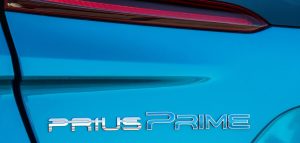
Ford’s two plug-in offerings, the C-Max Energi and Fusion Energi, both have more driving feel than the Prius Prime, but their all-electric driving range falls behind with 19 miles. However, their base price gives the Fords a slight edge. Hyundai’s Sonata plug-in hybrid offers 27 miles of EV driving range and does so with a standard transmission that gives the car a more natural driving feel, but the base model is $7,000 more than the Prime. The Kia Optima plug-in hybrid mirrors the Sonata. And if you simply must have a Honda plug-in hybrid, one is on its way and will boast 40 EV driving miles.
If you’re a Toyota Prius devotee and want to move to a plug-in hybrid, you’ll likely buy a Prius Prime without comparison shopping. If you’re open-minded, as you’ve just read, there are several choices.
What you will find is the 2017 Toyota Prius Prime is unquestionably a great value from a tech perspective, offering more standard features than plug-in rivals with a lower price. The Prime, in all of its iterations, is a lot of eco-minded car for the money.
Related Stories You Might Enjoy:
Road Test: 2017 Toyota Prius Prime (John’s view)
Road Test: 2017 Ford Fusion Energi
Comparison Test: 2017 Kia Optima Hybrid & Plug-in Hybrid
Road Test: 2016 Chevrolet Volt
Road Test: 2017 Hyundai Sonata Plug-in Hybrid
Disclosure:
Clean Fleet Report is loaned free test vehicles from automakers to evaluate, typically for a week at a time. Our road tests are based on this one-week drive of a new vehicle. Because of this we don’t address issues such as long-term reliability or total cost of ownership. In addition we are often invited to manufacturer events highlighting new vehicles or technology. As part of these events we may be offered free transportation, lodging or meals. We do our best to present our unvarnished evaluations of vehicles and news irrespective of these inducements.
Our focus is on vehicles that offer the best fuel economy in their class. We also feature those that are among the top mpg vehicles in their class. In addition, we aim to offer reviews and news on advanced technology and the alternative fuel vehicle market. We welcome any feedback from vehicle owners and are dedicated to providing a forum for alternative viewpoints. Please let us know your views at publisher@cleanfleetreport.com.

4 thoughts on “Road Test: 2017 Toyota Prius Prime”